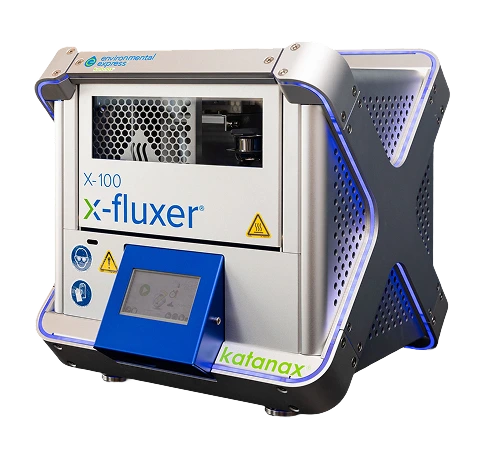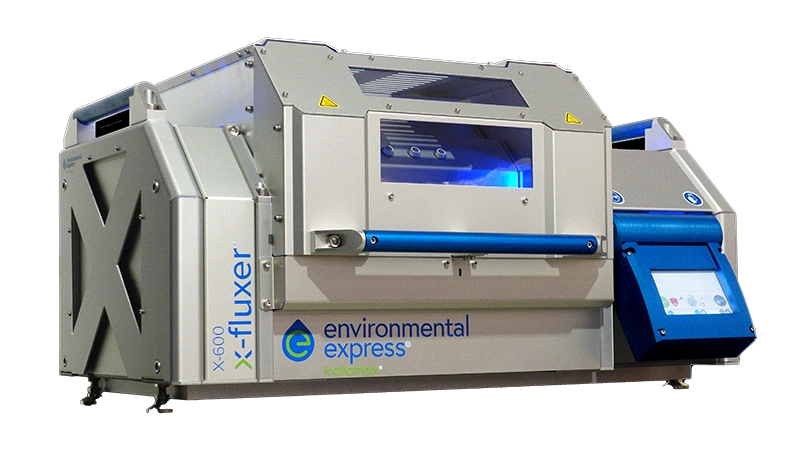


Compare X-100 | X-300 | X-600
To place an order, contact a sales representative at +1.418.915.4848 or via email to info@katanax.com
| Version | X-100 | X-300 | X-600 |
|---|---|---|---|
| Samples at a time | One (1) | X-300m (mono): 1 X-300d (dual): 2 X-300t (triple): 3 | Six (6) |
| Samples per hour, max* | Up to 5 | Up to 15 (with X-300t) | Up to 30 |
| Temperature range | 50–1200 ºC | 50–1200 ºC | 50–1200 ºC |
| Ability to make disks (XRF) | Yes | Yes | Yes |
| Ability to make solutions (ICP, AA) | Yes (1 position), with optional agitator | Yes (up to 3 positions), with optional agitator | Yes (6 positions), with optional agitator |
| Mixing action | Rocking action | Rocking action | Rocking action |
| Heater configuration | Closed furnace | Closed furnace | Closed furnace |
| Heating elements impervious to flux | Yes | Yes | Yes |
| Heating elements brittle after heating | No | No | No |
| Heating elements type | Sealed cartridge | Sealed cartridge | Sealed cartridge |
| Heating elements can be changed individually | Yes | Yes | Yes |
| Automatic power calibration to maintain uniform temperature | Yes, PID | Yes, DTP** (patent pending) | Yes, DTP** (patent pending) |
| Metal exposed in furnace | No | No | No |
| Mold heating | With crucibles | With crucibles | With crucibles |
| End-of-fusion signal | Sound and color LEDs (red=busy/hot, blue=standby/cool) | Sound and color LEDs (red=busy/hot, blue=standby/cool) | Sound and color LEDs (red=busy/hot, blue=standby/cool) |
| Temperature holding (faster heat-up) | Always, programmable | Always, programmable | Always, programmable |
| Safety shield | Yes | Yes | Yes |
| Interface screen | Color LCD touchscreen | Color LCD touchscreen, tiltable | Color LCD touchscreen, tiltable |
| USB port | Yes | Yes | Yes |
| Electrical connection | Plugs right into a regular outlet (with proper voltage) | Plugs right into a regular outlet (with proper voltage) | Plugs right into a regular outlet (with proper voltage) |
| External power box or coolant supply | None needed | None needed | None needed |
| Voltage | 115 or 230 VAC, 50/60 Hz | 115 or 230 VAC, 50/60 Hz | 115 or 230 VAC, 50/60 Hz |
| Power (max) | 1250 W | 3000 W | 4000W |
| Dimensions (H x W x D) | 42 x 42 x 42 cm (16.5 x 16.5 x 16.5 in.) | 51 x 48 x 63 cm (20 x 19 x 25 in.) | 56 x 105 x 69 cm (22 x 41 x 27 in.) |
| Weight | 22 kg (48.5 lb) | 45 kg (99 lb) | 90 kg (198 lb) |
* Samples per hour figures will depend on sample type, use of temperature holding and use of overlapping feature. Smaller throughputs may be obtained.
** The Dynamic Temperature Profile (“DTP”) automatically regulates the actual power fed to each individual element to compensate for supply voltage and element resistance variations, thus ensuring location-independent temperature uniformity.
Katanax Fluxers vs. Competition
Our fluxers exhibit many advantages over other sample preparation methods. Here are the other methods’ flaws that are overcome using our instruments:
Gas Disadvantages
- Safety issues: hot flames, risk of intoxication or explosion
- Poor temperature control
- Not the optimal environment for sample oxidation
- Affected by altitude
- Strong vent hood and custom gas piping required
Pressed Pellet Deficiencies
- Low precision and accuracy
- Mineralogical effects: In pressed pellets, specific atoms produce different XRF responses when bonded to different atoms (example, FeO, Fe2O3 and Fe3O4 will exhibit different XRF intensities, even if the Fe concentrations are known to be the same)
- Particle size effects: In pressed pellets, the XRF response varies with the size of the particles, so grinding can be critical
- Low homogeneity: In pressed pellets, a mechanical separation (segregation) of the sample’s components can occur, due to particle density, shape or size
- Synthetic standards are hard to make due to matrix effects
Magnetic Induction Shortcomings
- High initial and energy costs
- Fluid coolant required
- Temperature difficult to monitor and maintain temperature
Digesters and Microwave Oven Flaws
- Lower precision and accuracy due to sometimes incomplete dissolution of the sample
- Very long preparation time (hours) for many sample types (e.g. refractories and silicas)
- Often required dangerous acids, such as HF and HCIO4

